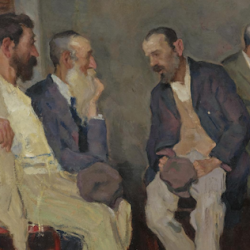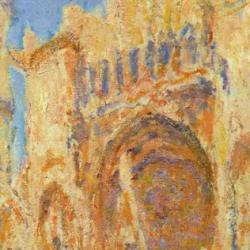Peter Adamson (Philosophy in the Hellenistic and Roman Worlds) claims that “A good case can be made for seeing Plotinus as the most in fluential Western philosopher of all time, apart from Plato and Aristotle themselves.” He fused Plato with some of Aristotle’s ideas, added Stoic concepts, to create what he called “Platonism” and what we call “Neoplatonism.” It was deeply influential on Augustine, and through Augustine on all of Western Christian thought, and continued to have a direct effect on theologians like Thomas.
Plotinus conceived the world as a hierarchy with three essential layers: “At the top we have a first cause, which is more or less familiar from the Middle Platonists: the One, also called the Good. It is comparable to a brilliant light that gives rise to a secondary light, like a ray shines out of the sun. This secondary principle is called by Plotinus nous,or ‘Intellect.’ . . . This Intellect is very like Aristotle’s God, a pure mind that does nothing but think—although this Intellect is not the First Cause, but secondary to the One. After the Intellect comes soul, the principle of life and order for the physical cosmos. Its function is to bring images of the Forms into matter, which results in the making of physical things.”
Adamson asks why Plotinus thought that everything originated in a simple, pure unity, the One? The answer, he says, had to do with the images of unity that he found in all things. To be a thing at all, a thing has to be one thing: “Without unity an army would just be a bunch of people standing around with an alarming amount of weaponry. And nothing can be a giraffe without being one giraffe.” Some things have an internal principle of unity and life – giraffes and sunflowers for example; other things have an imposed unity – armies and houses. But the unity is always there. If it is a thing it is one.
And if it is good and beautiful and healthy, it is also one: “What is health, after all, other than the cooperative ordering of the body’s parts, while illness is the result of these parts coming into conflict with one another? What is beauty but a kind of harmony? And what is harmony but a kind of unity?”
Now, the source of all things has to exhibit unity, but it cannot be the unity of a thing. It must be a unity that is beyond the unity of any particular thing. It must be unity and nothing but unity, “the One” or “the Good.” It must be incorporeal; it cannot be composed of parts: If it is a body or assembled from parts, it is no longer a pure unity. That this unity is inconceivable is not usually a problem for Plotinus: The One is beyond knowing, and beyond being.
It’s not clear how this argument works, though. A giraffe is one thing, for sure; but surely there is also a multiplicity inherent in being-giraffe, without with the giraffe would not be what he is. His one body has many parts; he has multiple relationships with multiple objects and patterns in his environment. The reasoning would seem to work better if we said that the ultimate source has to be something both One and Multiple.














